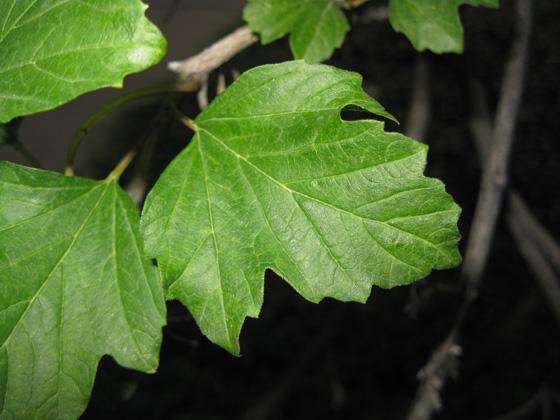| PSC 2620: Woody Trees and Shrub | Course Home | Week 2 |
Viburnum opulus - European Cranberrybush Viburnum
Plant Viewer
 |
 |
| The leaves have three lobes and large serrations on the margin. They are wider and shorter than those of V. trilobum. | Corymbs of sterile showy white flowers surround less showy inner flowers. These inner blossoms become the fruit. Image: Wikipedia |
 |
 |
| The clusters of 1/2 inch fruit ripen at the end of summer. Image: Wikipedia | Viburnum opulus has a nice mixture of yellow and orange color in the fall. Image: Wikipedia |
Plant Description
Viburnum opulus is a large (10 feet tall and wide) deciduous shrub with well-rounded shape. It is adaptable to many soil and site conditions and is considered a very tough and hardy shrub. Performs best, especially in berry production, in full sun.
The branching and foliage cover is very dense, making it an excellent choice for hedges and screens. The dark green 3-4 inch leaves are arranged opposite on the stem and have three large pointed lobes. The edge of the leaf is serrated. The leaves turn orangish-red in the fall.
White flowers appear in rounded corymbs with showy white flowers forming a ring around a larger cluster of inconspicuous smaller white flowers. Bright red berries appear in late summer and persist through the fall, but by winter they appear shriveled and of little aesthetic value.
Landscape Use
Performs very well as a hedge or screen. Can also be used as a flowering accent plant.
Points of interest
Viburnum opulus is very susceptible to aphids, and infected bushes should be treated immediately. The berries are attractive to birds, but they are mildly poisonous to humans.
Notable Cultivars
Compactum: About half the size of the regular species (4-6 feet tall and wide) with good flower and fruit production..

Nanum: A dwarf form (2 feet tall and wide) that has a very dense habit and a good globular form. It very rarely flowers or sets fruit. Its small size and excellent form makes it a popular accent plant. Pictured above in 3d.
Sterile (or Roseum): Also known as Snowball Bush. The large white double blooms resemble snowballs and appear profusely all over the bush.
